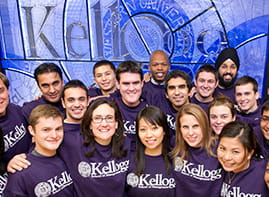Links between race and crime topic of Kellogg talk
Kellogg diversity research center begins second series of distinguished lectures
By Amy Trang10/24/2008 - Some may think that race is no longer an issue in America, but studies prove racial bias still plays a big role in society, linking black Americans with crime and even animal-like features.
That was Stanford University Professor Jennifer Eberhardt’s message to the nearly 100 people who attended her Oct. 22 discussion in the Norris University Center. The talk began the second series of lectures sponsored by the Center on the Science of Diversity, a collaboration between the Kellogg School and Northwestern University’s Weinberg College of Arts & Sciences.
The associate professor of psychology presented her findings on the links between race and crime and race and dehumanization. Her talk was titled, “The Criminalization and Dehumanization of Blacks in the Modern Era.”
Eberhardt explained that most white Americans believe that discrimination of blacks is a thing of the past, with a majority of them reporting that they are not concerned with racial issues.
But Eberhardt and her colleagues’ research shows that race influences people more often than they believe. In one study, participants were subliminally primed with a series of black or white faces on a computer screen. Then, participants were slowly exposed to crime-relevant objects. The results found that participants tended to recognize crime objects quicker when exposed to black faces in the primer versus white faces in the primer.
“When people think black, they think crime,” Eberhardt said. “It happens the opposite way as well. When people think crime, they think black, so blacks are being placed under surveillance.”
This has consequences in terms of capital punishment, she notes. Another study found that more “black” features in a defendant causes him or her to more than twice as likely to get the death sentence as a lighter-skinned African-American defendant found guilty of killing a white person.
Dehumanization of blacks is another topic that was examined in several studies. Eberhardt admitted being surprised at the results, which showed that Americans subconsciously associate blacks with apes, although that stereotype is largely unrecognized in modern society.
“One of the battles that blacks fight is to be recognized as fully human,” Eberhardt said. “Animal imagery increases people’s thirst for violence toward blacks.”
One study that supported Eberhardt’s conclusions was similar to the black-crime study, in which participants were subliminally exposed to black or white faces before asked to identify ape drawings. The researchers found that participants were likely to identify the ape quicker when primed with black faces than with white.
Another study also found more animal imagery, using words such as “savage” or “beast,” in news articles about black criminals versus white criminals.
The results of the dehumanization research were shocking to Eberhardt. She said that the findings are too significant for it to go without comment.
“Even with no explicit hatred, black-crime, black-animal associations remains,” Eberhardt said. “It shows the power of racial bias.”
The Center on the Science of Diversity opened in January, and is dedicated to promoting dialogue and interdisciplinary research about diversity. The center’s co-directors are Katherine Phillips, associate professor of management and organizations, and Galen Bodenhausen, the Lawyer Taylor Professor of Psychology and Marketing.






